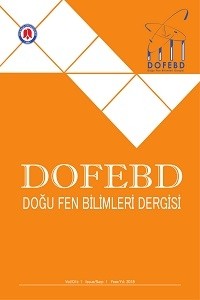The Effect of Magnetic Field on Three Different Varieties of Soybean Seed
Soybean, Glycine max (L.) Merrill, magnetic field, germination
___
- Aladjadjiyan, A., Ylieva, T. (2003). Influence of stationary magnetic field on the early stages of the development of tobacco seeds (NicotıanaTabacum L.). Journal of Central European Agriculture (online), 4 (2): 132-138.
- Anaç, H., Ertürk, Y. E. (2003). Soybean. TEAE-Bakış, ISSN 1303- 8346.
- Atak, Ç., Alikamanoğlu, S., Danilov, S., Rzakoulieva, A., Yurttaş, B., Topçul, F. (2000). Effect of magnetic field on paulownia seeds. Com. J. I. N. R. Dubna, 231: 1-14.
- Atak, Ç., Çelik, Ö., Olgun, A., Alikamanoğlu, S. , Rzakoulieva, A. (2007). Effect of magnetic field on peroxidase activities of soybean tissue culture. Biotecnol. & Biotechnol . EQ., 2: 166-171.
- Belyavskaya, N. A., Fomicheva, V. M., Govorun, R. D., Danilov, V. I. (1992). Structural-functional organization of the meristem cells of pea, lentil and flax roots in conditions of screening the geomagnetic field. Biophysics, 37 (4): 657-666.
- Carbonell, M. V., Martinez, E., Amaya, J. M.(2000). Stimulation of germination on rice (Oryzasativa L.) by a statmagnetic field. Electro and Magneteobiology, 19(1): 121-128.
- Conger, B. W., Nilan, R. A., Konzak, C. F., Metter, S. (1966). The influence of seed water content on the oxygen effects in irradiation barley seeds. Radiation Botany, 6: 129- 144.
- Đukıć, V., Miladinov, Z., Dozet, G., Cvanovıćıj, M., Tatıć, M., Mıladınovıć, J., Baleševıć-Tubıć, S. (2017). Pulsed electromagnetic field-a cultivation practice used to increase soybean seed germination and yield. Zemdirbyste-Agriculture, 104 (4): 345-352.
- Formicheva, V. M., Govorun, R. D., Danilov, V. I. (1992). Proliferative activity and cell reproduction in the root meristems of the pea, lentil and flax in the conditions of screening the geomagnetic field. Biophysics, 37(4): 645- 648.
- Gaul, H. (1977). Mutagen effect in the first generation after seed treatment. Manual on Mutation Breeding (2nd ed.), Technical Reports, Series 119, IAEA, Vienna, 87- 95.
- Goodman, E. M., Greenebaum, B., Marron, M. T. (1995). Effects of electromagnetic fields on molecules and cells. Int. Rew. Cytology A Survey of Cell Biology, 158: 279-338.
- Grundler, W., Kaiser, F., Keilmann, F., Walleczek, J. (1992). Mechanisms of electromagnetic interaction with cellular systems. Naturwissenschaften 79: 551- 559.
- Kataria, S., Baghel, L., Guruprasad, K. N. (2017). Pre-treatment of seeds with static magnetic field improves germination and early growth characteristics under salt stress in maize and soybean. Biocatalysis and Agricultural Biotechnology, 10: 83-90.
- Lebedev, S. I., Baranskii, P. I., Litvinenko, L. G. , Shiyan, L. T. (1975). Physiobiochemical characteristics of plants after presowing treatment with a permanent magnetic field. Fiziologiya Rastenii, 22(1): 103-109.
- Martinez, E., Florez, M., Carbonell, M. V. (2017). Stimulatory effect of the magnetic treatment on the germination of cereal seeds. International Journal of Environment, Agriculture and Biotechnology, 2(1): 375-381.
- Nair, R. M., Leelapriya, T., Dhilip, K. S., Boddepalli, V. N., Ledesma, D. R. (2018). Beneficial effects of extremely low frequency (ELF) sinusoidal magnetic field (SMF) exposure on mineral and protein content of mungbean seeds and sprouts. Indian Journal of Agricultural Research, 52(2): 126-132.
- Oldacay Y., S. (2002) .Effects of magnetic fields on the gamma irradiated sunflower varieties (PhD. Thesis). İstanbul University, Institude of Science, İstanbul
- Orthoefer, F. T. (1978). Processing and utilization: soybean phiysiology agronomy and utilization (p.220-221).London: Academic Press.
- Poghosyan, G., Mukhaelyan, Z. H. (2018). The Influence of low-ıntensıty EMI treatment on seed germınatıon and early growth of wheat. Chemistry and Biology, 52(2): 110-115.
- Rochalska, M., Grabowska, K. (2007). Influence of magnetic field on the activity of enzymes: α and β amylase and glutathione s-transferase (GST) in wheat plants. Int. Agrophysics, 21: 185-188.
- Rochalska, M., Orzeszko-Rywka, A. (2005). Magnetic field treatment improves seed performance. Seed Science and Technology, 33(3): 669- 674.
- Şeker, S. , Korkut, A. (2005). Dangerous toy. İstanbul: Hayykitap- ISBN 95-9059-01-02, Emergency Series-1.
- Yalçin, S. , Tayyar, Ş. (2011). The effect of magnetic field on the germination and seedling growth of the seeds of lemon balm. YYU Journal Agriculture Science, 21(3): 190-197.
- Yalçin, S. (1992). Effect of gamma radiation on soybean (MSc. Thesis). İstanbul University, Institude of Science, İstanbul
- Zhang, Q., Li, Y., Chin, K. L., Qi, Y. (2017). Vegetable soybean: Seed composition and production research. Italian Journal of Agronomy, 12(3): 276-282.
- ISSN: 2667-6958
- Yayın Aralığı: Yılda 2 Sayı
- Başlangıç: 2018
- Yayıncı: Hakkari Üniversitesi
The Effect of Magnetic Field on Three Different Varieties of Soybean Seed
Tülay TOPRAK, Ruveyde TUNÇTÜRK
Elektrik Akımının Patates (Solanum tuberosum L.) Yumru Dormansisi Üzerine Etkisinin Araştırılması
Orthoptera Fauna of Aksaray and Konya Province in Middle Anatolia of Turkey
